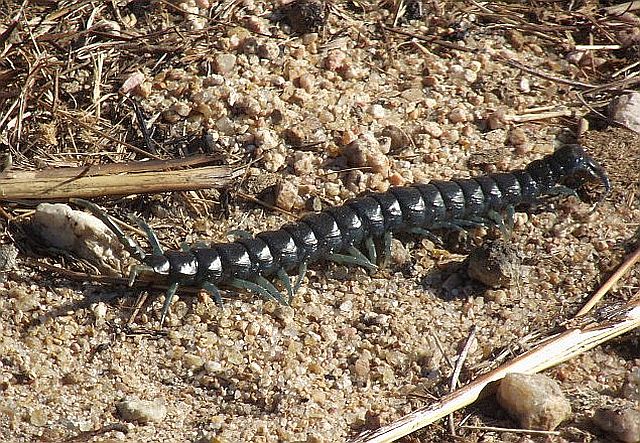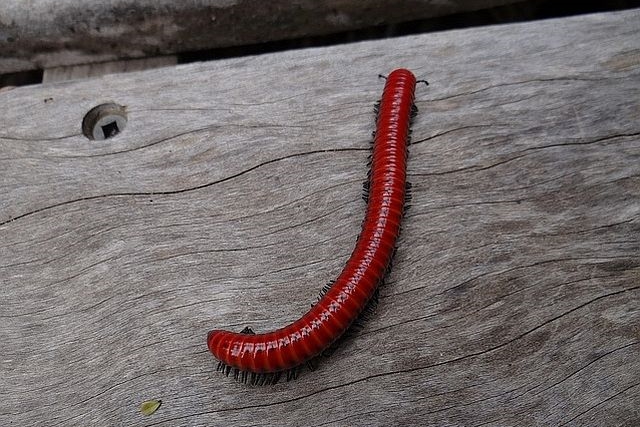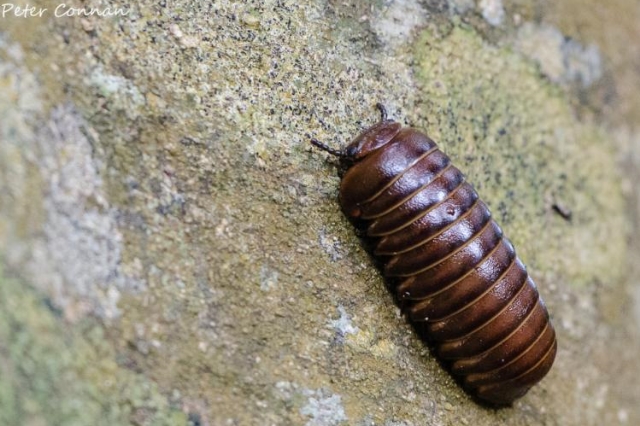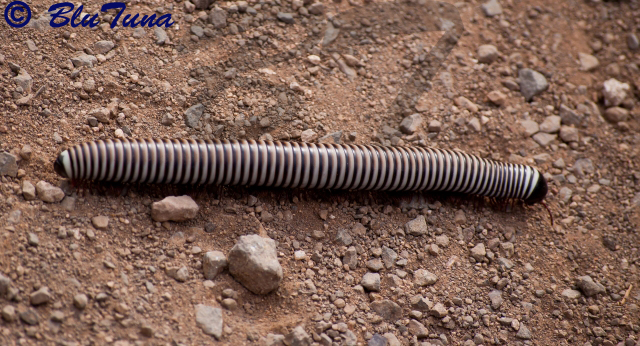Largespine Millipede Zinophora sp, possibly
Z. similis
Class Diplopoda. Order Spirostreptida. Family Harpagophoridae. Subfamily Harpagophorinae. Tribe Harpagophorini
Marloth Park © Richprins
Order Spirostreptida (Common Millipedes)
Body surface smooth, cuticle hardened.
Body with free sternites, lacking lateral projections, adult animals with more than 40 segments, eye patches ovoid or subtriangular; ozopores on each body segment from segment 5 or 6 onwards; gonopods retracted inside body cavity.
Spirostreptida millipedes are well represented throughout the Southern African subregion and comprise three families, the Harpagophoridae, Odontopygidae and Spirostreptidae. They are sexually dimorphic, with males smaller and more slender than females.
Spirostreptida millipedes are seasonally active and during the rainy months are particularly conspicuous in the dry, savannah habitats of Southern Africa. Surface activity is related to feeding and reproduction.
Reproduction
Millipedes are polygynandrous. Males initiate copulation by approaching females from behind and moving towards the head along the dorsal surface. In most Spirostreptida species, the mails coils his body around the female. Mate recognition is believed to be the consequence of a random walk, and based on a combination of tactile and chemical cue. In the Spirostreptidae the onset of copulation is associated with females attaching their mouthparts to species-specific prefemoral projections at the base of the male's first pair of legs.
Gonopores are paired structures that occur on the third body segment, just behind the second pair of legs. In females, they open into paired vulvae that are attached to the base of the second leg pair. In males they terminate in penes from which sperm are released. In addition to gonopores, males bear a pair of structurally complex intromittent genitalia called gonopods on their seventh body segment. These structures are normally drawn into the body so that only their distal ends are visible.
Sperm are translocated via the gonopods from the penes to the vulvae where they are stored.
Harpagophoridae (Spineplate Millipedes)
Medium to extremely large species
Anal segment extended to form an obvious spine
The millipede family Harpagophoridae is not only found in Africa, but also occurs in Southeast Asia and the East Indies. The family is represented in Africa by the following genera:
Poratophilus Silvestri, 1897 (two species);
Harpagophora Attems, 1909 (six species);
Zinophora Chamberlin, 1927 (21 species);
Apoctenophora Hoffman & Howell, 1982 (four species), and
Metaphora Redman, 2003 (one species).
Genus Zinophora Chamberlin, 1927
The most widely distributed and speciose genus of Harpagophoridae in Africa is
Zinophora, which ranges from the Western Cape (South Africa) and Namibia in the southwest, to Mozambique, Zimbabwe, Zambia, Malawi and Tanzania in the east. It is largely restricted to the savannah biome, but some species are adapted to rainforest conditions and others to the grassland biome. The genus includes 19 named species, of which 16 are from Africa south of the Zambezi and Kunene rivers.
Diagnosis: Telopodite with one or two simple femoral processes, where two spines present these of similar size. Apical elements comprising three components: the pectinophore, thumb and second lamella. Thumb narrow and falcate, or a saucer-shaped, laminate plate broadening apically, curving away from other apical elements. Distal ends of telocoxites complexly lobed. Prefemora of first legs not touching medially and syncoxosternum without suture.
Z. similis is common in the lowveld and the Kruger National Park.
This species aestivates in the deep interiors of large termite mounds.
Links:
https://bioone.org/journals/african-inv ... .0112.full
https://www.tandfonline.com/doi/pdf/10. ... 6.11447346
http://the-eis.com/elibrary/sites/defau ... Attems.pdf
https://bioone.org/journals/african-inv ... .0207.full
https://www.yumpu.com/en/document/read/ ... ertebrates
 © mposthumus
© mposthumus © Twigga
© Twigga
 © Lisbeth
© Lisbeth © Peter Connan
© Peter Connan © BluTuna
© BluTuna